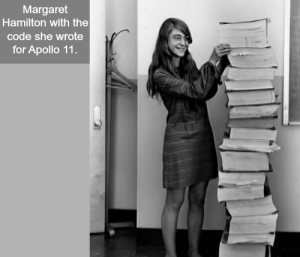
Most of the people who are passionate about computing know Ada Lovelace. Born 200 years ago (1815) her family background provided a mix of poetry (father) and mathematics (mother). An interesting mix, and I feel a necessary mix for great achievers. Being able to feel the dream-state of creativity, allows a different interpretation of the material, realistic world. I truly believe that there is no great invention without great creative vision, and to me Ada Lovelace had both traits which resulted in a magnificent addition to history, even today. There is a lovely FindingAda blog which celebrates the achievements of women in STEM. And today I loved reading the 40 years in tech FutureLearn blogpost by Shirley Williams.
Ada extending the machine
Going against the odds is not an easy thing. Anyone who is slightly different understands the impact of not being part of the norm. Ada must have known and felt it herself. Nevertheless, she had one big advantage, her interests paralleling passion that she could find close by, she had access to an incredibly professional learning network (admittedly, that would have been a very physical, face-to-face network at the time). It was Ada herself who described her scientific thoughts as ‘poetical science’. But what did she do? Ada managed to translate the operations of a machine, the Analytical Engine. She literally translated the Italian description of the analytical engine, but added her own notes to it: “Sketch of the Analytical Engine, with notes fromthe translator“. These notes are the blueprint of computer programming, and moved the machine beyond its mere materialistic capacity, towards a new use. It is this that has fascinated me about Ada (and more people with similar poetic scientific passion).
Within this day and age STEM (science, technology, engineering and maths) is of course still very important (history tends to have waves of interest, so STEM is bound to become less important in future historical era’s). And I love the fact that STEM is stimulated from a gender perspective. But it does make me think about what I feel we are missing, when thinking about Ada Lovelace?
The dysfunctional extended learning body
The best action movies are those where the actor/actress has to come up with new solutions ad hoc. A bit of MacGyver or the A-team… but with more women as heroes. This is what seems to be missing with a lot of algorithms. This: what if we hit a brick wall? Where do we turn next…. That is what I would love to see: more algorithms that can multi-iterate solutions. The reason why is because of the current dysfunctional learning body I have to live with in my digital world. I would love to see my digital, extended body to be equipped with a more solid network of solutions, allowing me to stay ‘in the flow’ when I am learning. I am looking for the new Ada that solves STEM affordances, translates them ready for use in our extended, learning body.
No matter what I do, I always seem to hit the brick wall of affordances multiple times. Even the more mature technologies can cut me off unexpectedly. Three days ago I was typing along, coding various data sets using DeDoose cloud software to code qualitative data.
Suddenly I felt like my arms dropped off. Physically they did not really disappear, but it felt that way. I was using the internet, wanting to search for something and … the connection broke. I felt like being at a library and suddenly losing the ability to use my arms. I know the library has the books I need (the internets), I even remember what isle to go to (structured search engines)… but I cannot reach them myself. So I did the only thing I could do… stare and hope for my digital arms to reappear again. I had similar experiences when exploring mobile learning, or using mobiles for learning, in the past. Or building mobile apps to be able to connect with digital, cloud-or-file-based content.
Of course coping with an extended, digital body means that multiple factors need to be part of any problem-solving algorithm: time management, what we mean with ‘flow of learning’, what provides the best possible experience of ‘learning flow’ (is it rather staying connected (for instance having an offline library that can step in with some bits when internet fails) or is it working with some sort of latency which can bridge failures in connectivity? Or anything that we can come up with.).
What affordances do we feel as useful? The first PDA was build based on real life experiences of its inventor walking around with a log. Affordances are in many cases ‘that what we find logical, or natural’, but it could be that what we find natural is not natural at all, simply something that works best given its realistic boundaries. What feels natural is not always transparent.
What would Ada do?
What kind of notes would Ada Lovelace add to a description of the extended learning body that we know have? Using social media, multiple (mobile) devices, connecting with people, learning in both formal and informal ways, moving towards an unknown professional future….? What would she come up with? Where does it leave me? How much of an Ada would I like to be (given my own personal boundaries and passions)… Where do we all see each other?
Source: http://goo.gl/v2Vn7u





